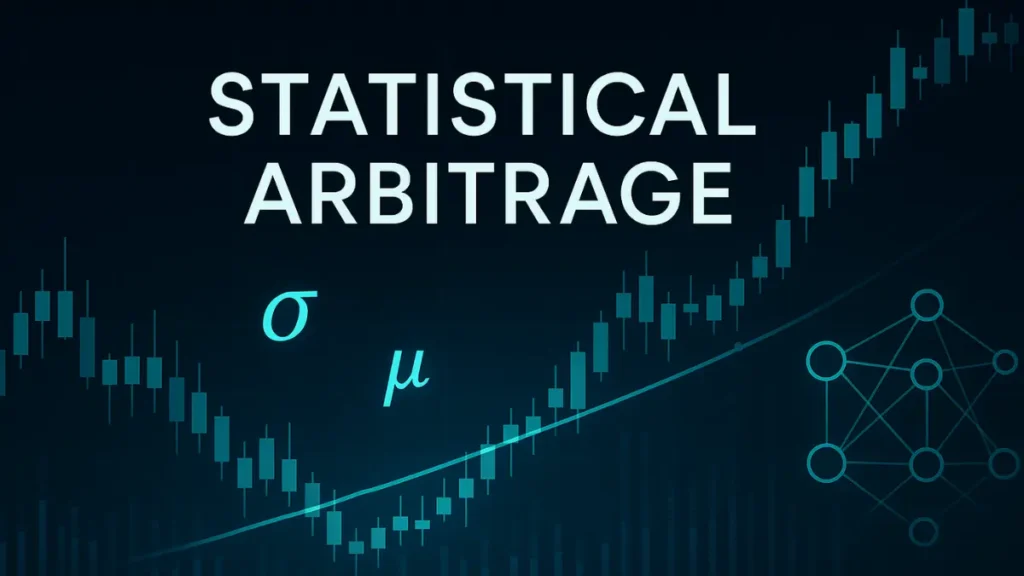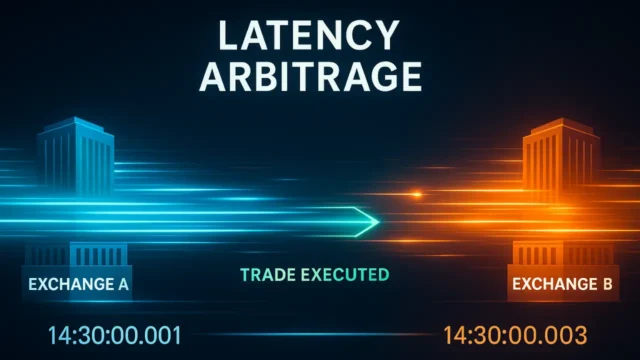Follow Us
Statistical Arbitrage | Strategies, Tools & How It Works

Table of Contents
- Key Takeaways
- What Is Statistical Arbitrage?
- The Mechanics of Statistical Arbitrage
- Core Models & Techniques of Stat Arb
- Benefits of Statistical Arbitrage
- Risks & Challenges in Stat Arb
- Tools & Technology for Stat Arb
- Applying Statistical Arbitrage as a Retail Trader
Markets may look chaotic, but beneath the noise lie patterns waiting to be uncovered. Statistical arbitrage or stat arb; is the science of detecting those patterns and monetizing them before they vanish.
Born at Morgan Stanley’s quantitative desks in the 1980s, statistical arbitrage became a flagship strategy for quant hedge funds and later evolved into a key tool for certain high frequency and algorithmic traders.
At its core, statistical arbitrage is not about predicting the market’s next move; it’s about betting on the reversion of relationships between securities.
If two stocks have historically moved in sync but suddenly diverge, a stat arb model might buy the laggard and short the leader, expecting the gap to close. Done correctly, this creates profits independent of the overall market’s direction.
But while the promise is attractive, the risks are equally real. Correlations break down, models fail, and crowded trades collapse without warning.
To understand statistical arbitrage fully, let’s break down its mechanics, applications, benefits, and pitfalls.
Key Takeaways
- Statistical arbitrage exploits short-term inefficiencies using math & probability.
- Models rely on mean reversion, correlation, and market-neutral setups.
- Execution speed & risk management determine real-world success.
- Risks include model decay, crowded trades, and unexpected shocks.
- Retail traders can apply simplified stat arb techniques with ETFs or pairs.
What Is Statistical Arbitrage?
Statistical arbitrage is a quantitative, market neutral strategy that profits from temporary mispricings between related securities.
Instead of relying on company fundamentals or news headlines, stat arb strategies lean on data driven models to detect when relationships between assets deviate from their historical norms.
The roots of stat arb trace back to the 1980s, when Morgan Stanley’s quant group pioneered pairs trading.
Traders noticed that companies with similar business models like Coca-Cola and Pepsi, tended to move together. When one stock diverged significantly, betting on a convergence often produced reliable profits.
This statistical observation evolved into increasingly sophisticated frameworks, eventually forming today’s multi asset stat arb strategies.
Unlike traditional arbitrage, where traders exploit guaranteed price mismatches (like a stock listed at different prices on two exchanges), statistical arbitrage is probabilistic.
It assumes that patterns in asset behavior, driven by correlations, cointegration, and mean reversion will hold true in the future.
For this reason, statistical arbitrage straddles an interesting middle ground. It’s neither pure speculation nor risk-free arbitrage, it is a bet backed by statistical evidence.
The Mechanics of Statistical Arbitrage
While strategies can be highly complex, most statistical arbitrage trades follow a basic cycle:
1. Identifying Relationships
Traders begin by scanning large universes of assets; stocks, ETFs, futures, currencies to find pairs or groups that historically move together.
For example, airline stocks like Delta and American Airlines might be tightly correlated due to shared industry factors.
2. Building Models
Once relationships are identified, statistical models are built to quantify them. Common approaches include:
- Z-Scores: Measuring how far the price spread deviates from its average.
- Linear Regression: Modeling one stock’s price as a function of another’s.
- Cointegration Tests: Identifying long term equilibrium relationships.
3. Triggering Trades
When the model detects a significant deviation; say one asset suddenly jumps while its pair lags, the strategy enters trades: short the outperformer, long the underperformer.
4. Closing Positions
As prices converge back to their equilibrium relationship, positions are closed, capturing profits from the reversion.
For example, imagine Coca-Cola and Pepsi. Historically, they move in near lockstep. If Pepsi surges while Coke lags, a stat arb model may short Pepsi and buy Coke. When the spread narrows, the trader profits from both legs.
Core Models & Techniques of Stat Arb
Statistical arbitrage has evolved well beyond simple pairs trading. Modern quant desks employ a wide toolkit of models, each with unique strengths and weaknesses.
Let’s break down the most widely used approaches:
1. Pairs Trading
The foundation of stat arb, pairs trading focuses on two historically correlated stocks. When the spread widens beyond a threshold, a convergence bet is made.
Despite its simplicity, pairs trading remains popular in equity markets and even extends into ETFs and crypto pairs.
2. Factor Models
Factor based statistical arbitrage looks beyond pairs, analyzing entire portfolios of stocks based on common risk factors such as value, momentum, volatility, or size.
The famous Fama-French Three-Factor Model, which accounts for market risk, size, and value forms the backbone of many institutional strategies.
While the Fama-French Three-Factor Model is not a trading strategy, it provides a framework for identifying and neutralizing systematic risk factors. Many statistical arbitrage strategies build on such models to isolate true alpha. Traders isolate mispricings by neutralizing exposure to these factors.
3. Principal Component Analysis (PCA)
As the number of securities grows, managing correlations becomes complex. PCA is a statistical technique that reduces dimensionality by identifying the main drivers of variation across assets.
Instead of analyzing thousands of correlations, traders can focus on a handful of principal components (like industry or macroeconomic drivers).
4. Machine Learning Integration
The cutting edge of stat arb involves applying machine learning techniques. Neural networks, random forests, and reinforcement learning can uncover nonlinear relationships and hidden patterns in price action.
These models adapt to changing market conditions faster than traditional statistical methods.
| Method | Strengths | Weaknesses |
|---|---|---|
| Pairs Trading | Simple, transparent, proven | Limited scalability |
| Factor Models | Diversified, robust | Sensitive to factor shifts |
| PCA | Handles large datasets efficiently | Harder to interpret |
| Machine Learning | Adaptive, powerful predictions | Risk of overfitting & opacity |
This blend of traditional statistics & modern AI represents the future of statistical arbitrage.
Benefits of Statistical Arbitrage
Why do hedge funds and quants flock to stat arb?
Several advantages make it one of the most attractive systematic strategies:
1. Market Neutrality
Stat arb strategies are typically designed to be market neutral. This means they aim to profit from relative price movements while hedging out overall market risk. In theory, whether the S&P 500 rallies or crashes shouldn’t matter.
2. Scalability Across Asset Classes
Although born in equities, statistical arbitrage can be applied to commodities, FX, bonds, and even crypto markets. Wherever relationships exist, stat arb can attempt to exploit them.
3. Discipline & Consistency
By relying on quantitative models rather than gut instinct, stat arb reduces emotional decision-making, a common downfall for retail traders.
4. Short Holding Periods
Unlike long term fundamental investing, stat arb trades are often held for hours to days. This allows for rapid capital turnover and compounding of profits if strategies are executed well.
5. Hidden Edge in Noise
Markets often look random in the short term, but statistical arbitrage thrives in that noise, finding repeatable patterns others overlook.
Risks & Challenges in Stat Arb
For all its promise, statistical arbitrage is not a free lunch. The same mathematical elegance that makes it appealing also makes it fragile when conditions shift. Here are the key risks:
1. Model Risk
Stat arb relies heavily on assumptions. If the statistical relationships identified in backtests don’t hold in the future, the model fails.
For example, two airline stocks may have moved together historically, but if one company changes its business model, the relationship may break.
2. Execution Risk
Even with a strong model, trades must be executed with precision. Latency (delays in execution), slippage (worse-than-expected fill prices), & liquidity traps (being unable to exit positions) can erode expected profits.
3. Structural Shifts
Markets evolve. Correlations that held for years can collapse during crises. The 2008 financial crisis saw traditional stat arb models suffer when normal relationships between stocks broke down amid panic selling.
4. Crowded Trade Problem
When too many funds use the same signals, the opportunity disappears. Worse, if everyone exits at once, small inefficiencies can snowball into systemic shocks.
The “Quant Meltdown” of August 2007 is a famous example, where several hedge funds lost billions in days due to crowded strategies unwinding.
5. Black Swan Events
Unexpected shocks, like geopolitical events, flash crashes, or COVID-19 can break statistical models overnight. Since stat arb positions often use leverage, these shocks can trigger outsized losses.
In short: statistical arbitrage can be highly profitable, but it’s also vulnerable to rare, catastrophic risks that wipe out months (or years) of gains in a week.
Tools & Technology for Stat Arb
Stat arb is as much about infrastructure as it is about models. Even the best ideas fail without the right tools.
Core Tools:
- Programming Languages: Python (pandas, statsmodels, scikit-learn), R, and MATLAB are staples for building & testing models.
- Backtesting Platforms: Tools like QuantConnect, Zipline, or in-house systems let traders simulate strategies on historical data.
- Machine Learning Libraries: TensorFlow, PyTorch, and XGBoost allow quants to push beyond linear models.
Execution Infrastructure:
- High Frequency Trading Platforms: For professional firms running ultra short horizon strategies, microsecond to nanosecond execution speed is critical.
- Broker APIs: Retail traders can connect to brokers like Interactive Brokers for automated execution.
- Data Feeds: High-quality, low-latency data is the lifeblood of stat arb. Tick level accuracy is essential for institutions.
Without the right technology stack, statistical arbitrage is just an academic exercise. With it, it becomes a living, adaptive strategy.
Applying Statistical Arbitrage as a Retail Trader

Many people assume stat arb is only for hedge funds with supercomputers and billions under management.
While it’s true that institutional stat arb operates at a scale beyond most retail traders, there are simplified approaches individuals can use:
1. ETF & Asset Pair Trading
Instead of focusing on ultra-tight spreads (which are nearly identical and leave little room for profit after costs), retail traders can target ETFs or assets with slightly looser but still reliable relationships.
2. Sector & Thematic Relationships
Retail traders can look for correlations between sectors or themes. For example, gold miners’ ETFs often move with gold prices but sometimes lag, offering convergence opportunities.
3. Factor Investing Lite
Without building complex multi-factor models, retail traders can explore free factor-screening tools to find relative mispricings. For instance, comparing value vs. growth ETFs or high volatility vs. low volatility stocks.
4. Practical Tips for Retail Stat Arb
- Backtest carefully: Avoid overfitting by ensuring your model works across multiple timeframes.
- Control risk: Use stop losses or volatility-based position sizing.
- Start simple: Begin with pairs trading before experimenting with complex machine learning models.
- Avoid speed contests: Institutions dominate ultra-fast execution. Retail traders can instead focus on daily or weekly reversion patterns where execution speed matters less.
For retail investors, the edge often comes not from speed but from exploring under-traded asset classes (like niche ETFs, emerging market stocks, or even crypto pairs) where inefficiencies persist longer.
FAQs
Is statistical arbitrage risk free?
No. Despite being market-neutral, stat arb carries risks from model assumptions, execution issues, and unexpected market events.
Can retail traders use statistical arbitrage?
Yes, but in simplified forms. ETFs, pairs trading, and factor based strategies are more realistic than high frequency setups.
Does statistical arbitrage still work in today’s efficient markets?
Yes, but the profit margins are slimmer. Success now depends on better models, cleaner data, & identifying overlooked inefficiencies.
Conclusion & Next Steps
Statistical arbitrage sits at the intersection of math, markets, & technology. From its origins in pairs trading to its current incarnation involving machine learning and high-frequency execution, it has proven to be one of the most adaptable quantitative trading strategies.
The core lesson is simple: inefficiencies exist, but exploiting them requires preparation, discipline, and humility. While profits can be extracted from short-term mispricings, models can fail in an instant, especially during market shocks or structural shifts.
What You Can Do Next:
- Experiment with simple pairs trading: Start with correlated pairs & test your strategy over different timeframes.
- Leverage free tools: Use Python, R, or platforms like QuantConnect to backtest strategies before committing capital.
- Scale with caution: Begin small, manage risk carefully, and remember that crowded trades can turn against you.
👉 If you’re new to algorithmic trading, check out our guide on algorithmic trading basics to build a foundation before diving deeper into stat arb models.
Final thought: Markets evolve, but inefficiencies never fully disappear. Statistical arbitrage is about spotting those fleeting gaps and turning market noise into profits.
Disclaimer:
This content is for informational purposes only and should not be considered financial advice.
Read full Disclaimer.




